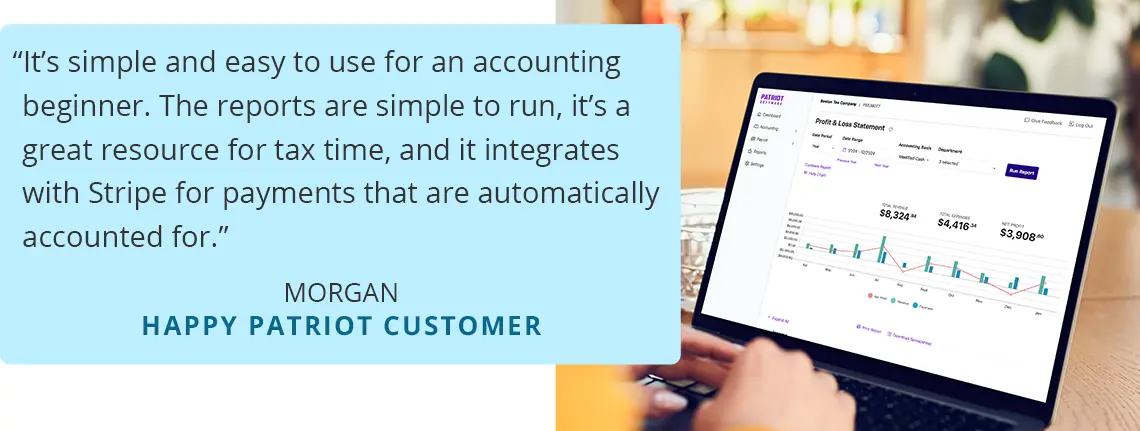Chances are you’ve eaten at a food truck before. A food truck is a mobile restaurant, often selling food at designated areas, street corners, or festivals and special events. Food trucks may be a great way to turn your dream of owning a restaurant into a reality. If you’re considering running a food truck, you’re in the right place. Read on to learn how to run a food truck.
How to run a food truck
Food trucks aren’t a passing fad. There are 36,324 food trucks in the U.S. And, the market size for food trucks grew from over $534 million in 2012 to nearly $1.5 billion in 2022.
But, most food trucks—up to 60%—close after three years. With the right knowledge and determination, you can keep your food truck up and running and turn a profit.
Here’s what you need to do to run a successful food truck business:
- Create a starting a business checklist
- Learn food truck accounting basics
- Understand your operating expenses
- Deduct your business expenses
1. Create a starting a business checklist
If you’re wondering, “How to start my own food truck business?” there are a few important things you’ll have to check off your list. You need to first create a starting business checklist.
Generally, the best checklists ask you to:
- Conduct market research: Look around your area and see what food trucks are already out there. Do you see a chance to improve the quality of food already offered, or will your food truck offer something no one else has seen?
- Draw up a business plan: When drawing up a business plan, explain how your food truck will meet consumers’ needs, the menu you’ll offer, and possible financing options.
- Secure funding: Look for investors, but don’t pass up help from the SBA or any grants that might be available. Some good options may include the Healthy Food Financing Initiative, Community Development Block Grant Program, and Rural Business Grants.
- Structure up your business: Common business structures include sole proprietorships, partnerships, limited liability companies, and corporations.
- Secure a vehicle, tools, and supplies: Make sure that both your vehicle and tools meet your immediate needs and can also handle the sustained business that’s sure to happen.
- Obtain permits and licenses: Get the necessary permits and licenses related to selling food (e.g., health permit, food service license, etc).
2. Learn food truck accounting basics
To make sure your food truck makes it, you’ve got to be on top of your accounting basics. Otherwise, you may have to close up shop like so many other food trucks.
Take a look at the importance of accounting for your food truck, according to Marius Grigoras, CEO of BHero,
Accounting is essential for the growth of your food truck business. As your business grows, you’ll need to make strategic decisions on investments, expanding your menu, or hiring new employees. Accounting provides you with the financial data needed to make informed decisions. By analyzing your financial records, you can identify opportunities for growth and make informed decisions about your business’s future. With good accounting practices, you can take your food truck business to the next level.”
Successful food truck owners have a solid understanding of food truck accounting, including:
- Cash flow
- Cost of goods sold (cogs)
- Profit margins
- Inventory
- Payroll
- Records
Cash flow
Your business cash flow is the amount of money that flows in and out of your business. Money leaves your business when you spend it on expenses like inventory and fuel. And, money comes in when you sell food, drinks, and different products. When managed properly, your cash flow lets you track, understand, and anticipate your food truck’s expenses and income.
If your food truck makes more money than it spends, you have positive cash flow. But if your expenses outpace your sales, you have negative cash flow. Negative cash flow means your food truck is operating at a loss (aka you’re losing money).
Positive cash flow can lead to a profit. Cash flow is the net amount of money moving in and out of your business. Profit is the amount of money you get to keep once you cover all of your expenses.
To help turn your cash flow into a profit, follow these steps:
- Prepare a cash flow statement
- Create and stick to your budget
- Cut costs when needed
- Increase sales
- Take advantage of early payment discounts offered by vendors
- Keep some cash on reserve
Cost of goods sold
Your cost of goods sold (COGS) is the amount of money your food truck spends to create your product. A food truck’s COGS can include labor and the materials needed to do your job (e.g., cooking fuel, gasoline, and ingredients for your menu).
Generally, the COGS for your food truck shouldn’t exceed 35% of your sales. If your COGS are too high, you may struggle to make a profit. So, how can you keep your COGS low enough to be successful?
Here are some ways to keep your cost of goods low:
- Keep track of your cost of goods and how they affect your revenue
- Make sure to price your menu according to your COGS
- Manage your inventory to prevent food waste
Profit margins
How to run a successful food truck often comes down to your profit margin. Your food truck’s profit margin measures the percentage of revenue you keep after covering outgoing expenses. In other words, profit margin lets you know your profit for each dollar of sale.
There are three ways to understand your profit margins:
- Gross profit margin: Your income after accounting for COGS
- Net profit margin: Your total revenue once you’ve accounted for expenses and income
- Operating profit margin: Includes the expenses of your overhead, operating, administrative, and sales needed to run your food truck day-to-day
Example
Let’s look at an example of a net profit for a food truck. But, before you can find your net profit, you first have to calculate your gross and net income. Your gross income is the amount of money your company has once you deduct your cost of goods sold (COGS) from your revenue.
Gross Income = Revenue – Cost of Goods Sold
Net income is your company’s total profits after you subtract business expenses from your gross income.
Net Income = Gross Income – Expenses
Once you have your net income, it’s easy to find your net profit margin. To calculate your food truck’s net profit margin, divide your net income by your revenue and multiply by 100.
Net Profit Margin = (Net Income / Revenue) X 100
So if your food truck has a revenue of $80,000, a cost of goods sold totaling $10,000, and expenses of $60,000, here’s how you break down the math to find your net profit margin.
First, you need to find your gross income. Subtract the cost of goods sold ($10,000) from your revenue ($80,000) to find your gross income of $70,000 ($80,000 – $10,000).
Next, subtract your expenses ($60,000) from your gross income ($70,000) to find your net income of $10,000 ($70,000 – $60,000).
Finally, divide your net income ($10,000) by your revenue ($80,000), and multiply by 100 to find your net profit margin. Your food truck’s net profit margin is 12.5% ($10,000 / $80,000) X 100.
To increase your profit margin, you can increase or diversify sales (e.g., offer branded swag), cut back on expenses, or raise prices.
Inventory
Running a food truck often comes down to your inventory. Managing inventory in a food truck is a science. You have limited space to store ingredients and must have an exact eye for portion control for menu items.
For example, if you sell pulled pork sandwiches and don’t precisely measure how much pork goes on each sandwich, you’ll have difficulty accurately managing your inventory. With rising food costs, a poorly managed inventory could spell disaster.
Here’s how you can get a hold of your food truck’s inventory:
- Do regular inventory counts to see if you’re ordering too much or too little of any ingredient (including herbs and spices).
- Measure your ingredients exactly and always stick to your recipes.
- Check to see what customers aren’t eating. If they don’t like it, there’s no reason to sell it.
Payroll
An easy way to disrupt your COGS and your bottom line is by not balancing the price of your menu items with the amount you pay your employees. If you pay your employees too much and can’t make up the difference through revenue, you’ll lose money quicker than you can say, “Order up!”
Here are some questions to ask yourself to make sure your payroll is on point for your food truck:
- Am I using the best pay frequency for my employees?
- Are my wages competitive for my industry?
- Are employee wages sustainable?
- Am I tracking employee attendance efficiently?
Despite what you may have heard, payroll doesn’t have to be a headache. With the right payroll software, you can streamline your process and return to what you love—serving delicious food to happy customers!
Records
A food truck is just like any other business. You must worry about your COGS and bottom line, and—of course—you must keep business records.
Here are six business records to track:
- Accounting records
- Payroll records
- Bank statements
- Business loans
- Legal documents
- Permits and licenses
- Insurance documents
Food truck recordkeeping can be complicated. You probably don’t have any extra space on your food truck to keep business records. If you can, consider keeping digital business records in the cloud with online accounting or storing them physically in a safe and secure location.
Remember that you should always keep licenses, permits, and insurance documents in the vehicle.
3. Understand your operating expenses
So, how much does it cost to run a food truck? CNBC notes that it may cost you $100,000 to get started. But, that number may be a little high. Depending on the condition of the truck, buying a food truck can cost you anywhere from $30,000 to $175,000. If you need to add features or a new paint job, you may have more expenses ahead of you.
You may be able to expect the following costs:
| Food Trucks | Food Trailer | Food Carts | Food Truck Businesses | |
|---|---|---|---|---|
| New, Equipped | $70,000+ | $9,395+ | $2,000+ | $200,000+ |
| New, Not Equipped | $20,000+ | $3,000+ | $539+ | N/A |
| Used Equipped | $8,000+ | $8,500+ | $1,000+ | $22,500+ |
| Used Not Equipped | $6,000+ | $3,000+ | $100+ | N/A |
Shopping for that perfect food truck? You might need to get a little creative, like Patriot customer The Coop Chicken and Waffles. Instead of buying a typical food truck/trailer, The Coop purchased, demolished, and transformed a small school bus.
Pro tip: You can deduct some of the costs from purchasing new business equipment if you don’t want to depreciate the costs over a long period. A business equipment deduction is a one-time tax deduction for business-related equipment (e.g., grills, generators, or ovens). Your food truck may also qualify for a Section 179 deduction.
4. Deduct your business expense
There’s no way to avoid business expenses; they’re just part of running any business. The good news is you can deduct business expenses for your food truck. Common business expenses for taxes include any costs you incur when operating your foot truck, like insurance, payroll, and even parking fees. When you deduct business expenses, you reduce your tax liability.
There are a few business deductions you should consider when running your food truck business:
- Self-employment tax: If you’re self-employed, you can deduct half of your self-employment tax.
- Business mileage: You can claim the business miles driven for your food truck.
- Employee wages: You may be able to deduct salaries, wages, bonuses, and other non-cash compensation for your employees.
- Advertising expenses: You may be able to deduct business-related advertising expenses.
- Vendor tax: You can claim a deduction on 50% of your gross receipts because you sell food products.
Hit the road with Patriot Software. Patriot’s accounting software can help you track expenses, income, and money to stay ahead of the competition. Try it for free today!
This is not intended as legal advice; for more information, please click here.



